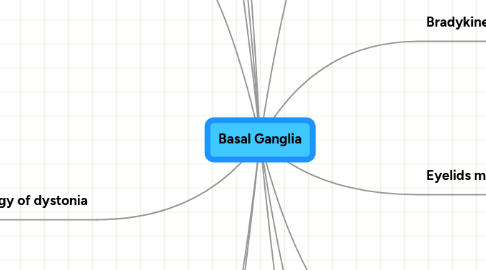
1. Functions
1.1. picture
2. Somatosensory discemination: study procedure
2.1. Conte et al Brain 2010
3. Experimental parkinsonism and lessons from surgery
3.1. Putamen,STN and GPi, show an increased neuronal response to peripheral stimulation with impairment of normal filtering of incoming signals.
3.1.1. Picture
4. Synaptic plasticity
4.1. Acitivty dependent modification of the strength or efficacy of synaptic transmission at preexisting synapses (short term and long term plasticity)
4.2. Prescott et al. 2009
4.2.1. Synaptic plasticity at the level of Substantia nigra pars reticulata
4.2.2. Pathophysiology of PD and synaptic plasticity
4.3. Transcranial magnetic stimulation: studies of plasticity
4.3.1. Gilio et al, Mov. Disord 2002
4.3.2. Short-term plasticity is reduced in PD
4.4. Long term plasticity
4.4.1. Measurement with iTBS
4.4.2. Picture
4.4.3. in PD long term potentiation is much less
5. The dorsal premotor cortex (PMd) in PD
5.1. selecting appropriate movements
5.2. suppressing other activities
5.3. Experimental paradigm
5.3.1. record in different areas
5.4. TMS in PD
5.4.1. in PD there's an altered PMd-to M1 activity
6. Bradykinesia
6.1. can be seen as a defect of motor circuit to generate a phasic inhibition of HPi neurons and facilitate cortical activation.
6.2. problems with performing simultaneous movement due to connectivity problem
6.3. picture
7. Pathophysiology of dystonia
7.1. excessive and sustained muscle contractions causing abnormal postures and involuntary movements
7.2. also cerebellum may be involved
7.3. Neuronal activity in dystonia
7.3.1. Reduced firing rates and altered patterns of neuronal activity in the GPi during pallidal surgery
7.3.2. picture
7.4. Cortical plasticity and connectivity in dystonia
7.4.1. increased excitability of m1 and of brainstem neurons
7.4.2. increased short-term plasticity and long-term plasticity at m1
7.4.3. functional connectivity between PMd and M1 is abnormal. Differently from healthy subjects in dystonia cTBS over PMd had any significant effect on MEPs. The PMd-M1 connectivity is reduced (Huang et al 2010)
7.5. Shared neurophysiological findings of focal organic dystonias
7.5.1. picture
8. Pathophysiology of dyskinesia in experimental PD
8.1. Picconi et al 2003, pisani et al 2005
8.2. Intermittent TBS over M1 showed that PD patients with LIDs do not have the normal increase in MEP size
8.3. Morgante et al Brain 2006
8.4. Suppa et al 2010
8.4.1. not published yet
9. Functional Circuitry
9.1. picture
9.1.1. picture
9.2. picture
9.3. Functions
10. Movement analysis of Bradykinesia in PD
10.1. Small first EMG agonis burst, additional bursts (failur to energize movements) during arm and ahnd movements
10.2. failure to match EMG parameters to the size of movements required (inappropriate scaling of movement)
10.3. Difficulty in self-initiated and externally triggered arm movements (more self initiated)
10.4. impairment of individual finger movements more than gross hand movements
11. Bradykinesia and DBS-STN
11.1. Agostino et al JNNP 2008, Agostino et al Mov. Disord 2008
11.2. picture
12. Eyelids movements in PD
12.1. Types
12.1.1. Voluntary
12.1.1.1. internal/external command
12.1.2. spontaneous
12.1.3. Reflex
12.1.3.1. external stimuli (visual, acoustic, kinetic)
12.2. PD patients
12.2.1. slowness in switching between the closing and opening phases of voluntary blinking.
12.2.2. Improvement after dopamine therapy
12.2.3. Agostino et al 2008 Movement Disorders, Bologna et al 2009 Brain
